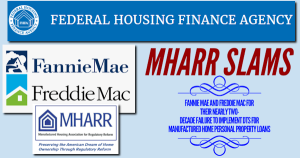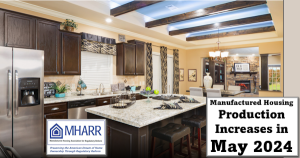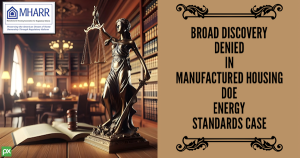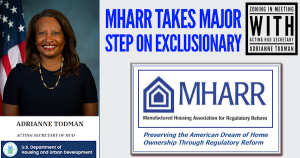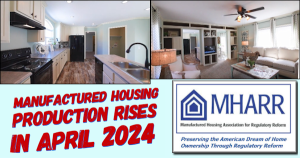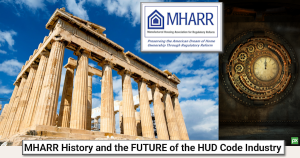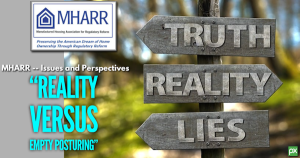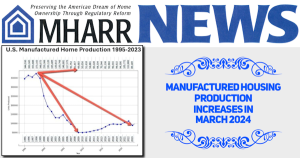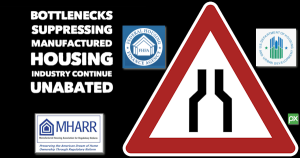“Ending The String Of Self-Inflicted Manufactured Housing Industry Wounds” January 2023 MHARR — Issues and Perspectives
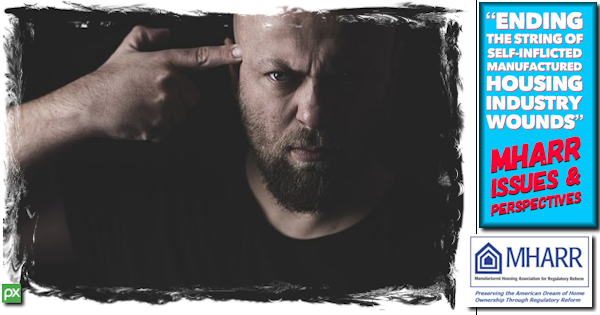
For generations, “newbies” of all sorts have been warned against reckless “volunteering.” The simple reason being that reckless “volunteering” can involve risks that lead to trouble, or worse. This basic formula for self-preservation, however, has apparently failed to sink-in with some representatives of the manufactured housing industry. Nor, apparently, have the harsh lessons of the recent “energy conservation” standards debacle. How else, then, to explain the fetish-like insistence of the Manufactured Housing Institute (MHI) – a self-professed “industry” trade group — on advancing a so-called “voluntary” federal fire sprinkler standard for manufactured homes? Is the National Association of Home Builders (NAHB) seeking similar treatment for site builders producing higher-cost (and in some cases million-dollar) homes? Not a chance. In fact, NAHB has – and continues – to do everything it can to stop the spread of residential sprinkler standards. So, why would the HUD Code industry volunteer for such abuse?
Indeed, it is mystery why MHI, instead of seeking to inflict a federal fire sprinkler standard on the HUD Code industry, has not formed an alliance with NAHB to oppose any and all such mandates – for any type of home — at the state and/or local level. Thus, while MHI routinely touts its cooperation with other segments of the housing industry to oppose or promote various legislation, programs and policies (See, MHARR’s July 26, 2022 White Paper, entitled “The Exploitation of Federal Housing Finance and Mortgage Funding Assistance Programs and Potential Solutions”) – in ways that are particularly beneficial to the site-built housing industry — it is nowhere to be found partnering with NAHB to oppose baseless sprinkler mandates.
This contradiction is especially relevant in the wake of the energy rule fiasco. One would think that after being slapped around by the U.S. Department of Energy (DOE) as “thanks” for supporting DOE’s phony 2015-2016 “negotiated” manufactured housing energy standards rulemaking process, MHI would have learned something about reckless “volunteering.” Apparently not, though, as that part of the industry, by supporting the introduction of a supposedly “voluntary” sprinkler standard into the HUD Code, stands poised – once again — to be bitten where it hurts, while this “one-two” punch (i.e., energy and sprinkler standards) increases regulatory cost burdens which will further limit the availability of affordable housing and the number of Americans who can afford to purchase a manufactured home, directly contrary to federal law.
The manufactured housing sprinkler standard debate has been around for decades. Not long after the adoption of the National Manufactured Housing Construction and Safety Standards Act of 1974, special interests were already clamoring for a federal manufactured housing sprinkler standard. MHARR, as one of its first priorities, aggressively opposed this effort, asserting that there was a clear basis under the 1974 law for the federal preemption of local sprinkler mandates. Quite simply, the HUD Code standards addressed (and have always addressed) “fire safety,” the same “aspect of manufactured housing performance” impacted by sprinklers, as shown by the National Fire Protection Association’s (NFPA) 13D standard, which is designed to “provid[e] a reasonable degree of fire safety.” And, in fact, the first official position taken by HUD with respect to sprinkler preemption adopted that exact analysis. In a July 27, 1989 communication to the Fire Chief of Oklahoma City, the then-Director of HUD’s Manufactured Housing and Construction Standards Division stated: “If your municipal requirements include automatic fire sprinkler systems, they address the same aspect of performance as HUD’s standards, i.e., fire safety. Therefore, HUD’s standards preempt.” (Emphasis added).
This common-sense position held until HUD’s Office of General Counsel (OGC) intervened years later. As shown by MHARR Freedom of Information Act (FOIA) requests, HUD lawyers argued in confidential memoranda for preemption under the 1974 law – and its crucial “same aspect of performance” test – to be construed narrowly. This set up a framework that could be corruptly manipulated to defeat federal preemption by simply re-defining, in an ever-narrower way, the alleged purpose of any regulation. Under this framework, the straightforward notion that HUD’s existing “fire safety” standards and local sprinkler mandates both addressed “fire safety” – and, therefore, the “same aspect of manufactured housing performance” – was rejected. Instead, localities were informed that while the existing HUD standards addressed “fire safety,” local sprinkler mandates addressed “fire suppression” – supposedly something completely different.
HUD, therefore, nullified preemption under the 1974 Act via an “interpretation” that made it virtually meaningless. MHARR (with no help from MHI) vigorously opposed this action and stressed its absurdity to Congress when it came time to reform the 1974 Act. Given direct evidence showing that HUD lied in statements claiming that preemption under the 1974 Act was being construed “broadly,” when just the opposite was the case, Congress decided to make the issue crystal clear. As a result, the 2000 reform law added language stating that “federal preemption … shall be broadly and liberally construed ….” (Emphasis added). As a result, the 2000 reform law, statutorily invalidated all prior HUD preemption decisions based on the post-1989 narrowing of the “same aspect of performance” test.
This in itself could – and should – have set the stage for industry-wide pressure on HUD to fully preempt local sprinkler standards for manufactured homes. The argument for preemption, however, was strengthened even further in 2011, when NFPA, under direct pressure from MHARR, was forced to concede that HUD Code homes, in key fire safety metrics, were as safe or safer than site-built homes (thus bringing its statistical analysis into alignment with the findings of multiple Foremost Insurance Company studies). No less an “authority” than NFPA, accordingly, confirmed that the HUD fire safety standards – without sprinklers – ensure the “reasonable fire safety” of manufactured homes.
These developments — the enhancement of federal preemption under the 2000 reform law and objective proof of the fire safety of HUD Code homes, without the use of or need for fire sprinklers – should have been the end of both the fire sprinkler and fire sprinkler preemption debate, by conclusively establishing:
- That HUD Code homes built to the federal standards are already fire safe, without sprinklers;
- That a sprinkler mandate would unnecessarily add to the cost of manufactured homes without materially enhancing fire safety; and
- That, as “broadly and liberally” construed, “fire safety” is the same aspect of manufactured home performance addressed by both the federal standards and local fire sprinkler standards.
And, in fact, MHARR relied on these crucial points to aggressively re-assert – against specious HUD opposition — its call for the full preemption of sprinkler mandates based on the current HUD Code fire safety standards (i.e., without any type of sprinkler provision).
And that is where the sprinkler debate should have ended. With no federal sprinkler standard and with local sprinkler mandates preempted. But even in the absence of federal preemption, the entire matter should have been left at the local level, with HUD Code manufacturers following the provisions of NFPA 13D to address the small number of situations – and smaller number of jurisdictions – where sprinklers needed to be addressed. This would have left the HUD Code out of the debate and avoided saddling a much larger number of manufacturers and consumers with a sprinkler standard, but MHI could not be dissuaded.
Instead, MHI (just as it has failed to hold HUD’s feet to the fire on the federal preemption of discriminatory zoning excluding manufactured homes), offered HUD an escape hatch from its illegitimate refusal to preempt local sprinkler mandates. Taking its cue from HUD’s baseless argument that even under the enhanced preemption of the 2000 reform law, the HUD “fire safety” standards – without an express sprinkler provision – would not preempt local sprinkler mandates, MHI, in 2011, proposed the inclusion of a so-called “voluntary” sprinkler provision in the HUD Code (based on NFPA 13D) that would govern sprinkler systems in manufactured homes where they were sought by consumers or otherwise required by local (or state) law. And now, eleven years later, this MHI-proposed “voluntary” sprinkler standard has been included in a Notice of Proposed Rulemaking (NPRM) issued by HUD on July 19, 2022.
Simply put, though — and as MHARR stressed in written comments on the NPRM filed in August 2022 — a “voluntary” federal sprinkler standard, as advanced by MHI, is little more than a trap that the industry is unwittingly stumbling toward. Aside from the undeniable fact that any type of sprinkler standard is unnecessary, since HUD Code homes are already fire safe, as documented by NFPA, the following should be obvious as well:
- There is no basis in the 1974 Act, as amended, for a “voluntary” or “conditional” federal manufactured home construction or safety standard of any kind;
- A “voluntary” HUD standard would not remain “voluntary” for long given regulatory “mission creep” and multiple special interest constituencies with an incentive to press for mandatory imposition. In the case of fire sprinklers, those constituencies, include HUD’s entrenched monitoring contractor and the special interest sprinkler lobby itself, both of which would financially benefit from a massive regulatory expansion;
- An express federal sprinkler standard, as explained above, is not a prerequisite for federal preemption of local sprinkler mandates, especially under the enhanced preemption of the 2000 reform law;
- The adoption of a federal fire sprinkler standard, even if “voluntary,” will have severe impacts on the availability and affordability of manufactured homes, including, but not limited to: increased consumer costs for sprinkler-equipped homes; increased financing costs for such homes; increased production and design costs for sprinkler-equipped homes; increased insurance costs for non-sprinklered manufactured homes; and increased lot rents and placement fees based on needed upgrades to community infrastructure, among other things;
- While the site-built housing industry is vehemently opposing sprinklers in their homes, the adoption of a federal manufactured housing sprinkler standard will be portrayed by industry competitors, detractors and others as demonstrating that HUD Code homes need additional fire safety protection, even though NFPA has deemed manufactured homes to be as fire safe or safer than other types of homes;
- The adoption of a federal manufactured housing sprinkler standard will be cited and manipulated by trial lawyers to assert that HUD Code manufacturers, retailers and/or communities that do not equip their homes with sprinklers (or do not have the infrastructure necessary to support sprinklers) are negligent in the event of a fire loss, injury, or death; and
- Even a “voluntary” or “conditional” standard would place significant pressure on community owners to either provide the water storage and related systems necessary to support a significant number of sprinkler-equipped homes — and thereby incur costly water system upgrades — or face the prospect of litigation and liability.
And even these pitfalls do not exhaust the full range of dangers to the availability, affordability and utilization of HUD Code manufactured homes that would flow from a misguided, unnecessary and needlessly costly federal manufactured home sprinkler standard of any kind.
As the entire industry should know by now, “going along” with regulators does not work for a comprehensively federally-regulated industry like manufactured housing. That was demonstrated with glaring clarity by the entire energy rule fiasco, which capped off years of self-inflicted industry wounds. The energy debacle also shows that the time to stop an unnecessary and destructive rule is as early as possible in the rulemaking process. As a result, the industry should assert its strong opposition to any federal fire sprinkler standard, as MHARR has, and as has been the case with representatives of other segments of the housing industry. Learning the lessons of past failures is key to future survival and prosperity, while those who refuse to learn the lessons of history are destined to repeat them.
Mark Weiss
MHARR is a Washington, D.C.-based national trade association representing the views and interests of independent producers of federally-regulated manufactured housing.
“MHARR-Issues and Perspectives” is available for re-publication in full (i.e., without alteration or substantive modification) without further permission and with proper attribution.
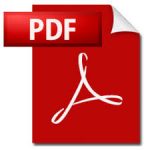
For generations, “newbies” of all sorts have been warned against reckless “volunteering.” The simple reason being that reckless “volunteering” can involve risks that lead to trouble, or worse. This basic formula for self-preservation, however, has apparently failed to sink-in with some representatives of the manufactured housing industry. Nor, apparently, have the harsh lessons of the recent “energy conservation” standards debacle. How else, then, to explain the fetish-like insistence of the Manufactured Housing Institute (MHI) – a self-professed “industry” trade group — on advancing a so-called “voluntary” federal fire sprinkler standard for manufactured homes? Is the National Association of Home Builders (NAHB) seeking similar treatment for site builders producing higher-cost (and in some cases million-dollar) homes? Not a chance. In fact, NAHB has – and continues – to do everything it can to stop the spread of residential sprinkler standards. So, why would the HUD Code industry volunteer for such abuse?
Indeed, it is mystery why MHI, instead of seeking to inflict a federal fire sprinkler standard on the HUD Code industry, has not formed an alliance with NAHB to oppose any and all such mandates – for any type of home — at the state and/or local level. Thus, while MHI routinely touts its cooperation with other segments of the housing industry to oppose or promote various legislation, programs and policies (See, MHARR’s July 26, 2022 White Paper, entitled “The Exploitation of Federal Housing Finance and Mortgage Funding Assistance Programs and Potential Solutions”) – in ways that are particularly beneficial to the site-built housing industry — it is nowhere to be found partnering with NAHB to oppose baseless sprinkler mandates.
This contradiction is especially relevant in the wake of the energy rule fiasco. One would think that after being slapped around by the U.S. Department of Energy (DOE) as “thanks” for supporting DOE’s phony 2015-2016 “negotiated” manufactured housing energy standards rulemaking process, MHI would have learned something about reckless “volunteering.” Apparently not, though, as that part of the industry, by supporting the introduction of a supposedly “voluntary” sprinkler standard into the HUD Code, stands poised – once again — to be bitten where it hurts, while this “one-two” punch (i.e., energy and sprinkler standards) increases regulatory cost burdens which will further limit the availability of affordable housing and the number of Americans who can afford to purchase a manufactured home, directly contrary to federal law.
The manufactured housing sprinkler standard debate has been around for decades. Not long after the adoption of the National Manufactured Housing Construction and Safety Standards Act of 1974, special interests were already clamoring for a federal manufactured housing sprinkler standard. MHARR, as one of its first priorities, aggressively opposed this effort, asserting that there was a clear basis under the 1974 law for the federal preemption of local sprinkler mandates. Quite simply, the HUD Code standards addressed (and have always addressed) “fire safety,” the same “aspect of manufactured housing performance” impacted by sprinklers, as shown by the National Fire Protection Association’s (NFPA) 13D standard, which is designed to “provid[e] a reasonable degree of fire safety.” And, in fact, the first official position taken by HUD with respect to sprinkler preemption adopted that exact analysis. In a July 27, 1989 communication to the Fire Chief of Oklahoma City, the then-Director of HUD’s Manufactured Housing and Construction Standards Division stated: “If your municipal requirements include automatic fire sprinkler systems, they address the same aspect of performance as HUD’s standards, i.e., fire safety. Therefore, HUD’s standards preempt.” (Emphasis added).
This common-sense position held until HUD’s Office of General Counsel (OGC) intervened years later. As shown by MHARR Freedom of Information Act (FOIA) requests, HUD lawyers argued in confidential memoranda for preemption under the 1974 law – and its crucial “same aspect of performance” test – to be construed narrowly. This set up a framework that could be corruptly manipulated to defeat federal preemption by simply re-defining, in an ever-narrower way, the alleged purpose of any regulation. Under this framework, the straightforward notion that HUD’s existing “fire safety” standards and local sprinkler mandates both addressed “fire safety” – and, therefore, the “same aspect of manufactured housing performance” – was rejected. Instead, localities were informed that while the existing HUD standards addressed “fire safety,” local sprinkler mandates addressed “fire suppression” – supposedly something completely different.
HUD, therefore, nullified preemption under the 1974 Act via an “interpretation” that made it virtually meaningless. MHARR (with no help from MHI) vigorously opposed this action and stressed its absurdity to Congress when it came time to reform the 1974 Act. Given direct evidence showing that HUD lied in statements claiming that preemption under the 1974 Act was being construed “broadly,” when just the opposite was the case, Congress decided to make the issue crystal clear. As a result, the 2000 reform law added language stating that “federal preemption … shall be broadly and liberally construed ….” (Emphasis added). As a result, the 2000 reform law, statutorily invalidated all prior HUD preemption decisions based on the post-1989 narrowing of the “same aspect of performance” test.
This in itself could – and should – have set the stage for industry-wide pressure on HUD to fully preempt local sprinkler standards for manufactured homes. The argument for preemption, however, was strengthened even further in 2011, when NFPA, under direct pressure from MHARR, was forced to concede that HUD Code homes, in key fire safety metrics, were as safe or safer than site-built homes (thus bringing its statistical analysis into alignment with the findings of multiple Foremost Insurance Company studies). No less an “authority” than NFPA, accordingly, confirmed that the HUD fire safety standards – without sprinklers – ensure the “reasonable fire safety” of manufactured homes.
These developments — the enhancement of federal preemption under the 2000 reform law and objective proof of the fire safety of HUD Code homes, without the use of or need for fire sprinklers – should have been the end of both the fire sprinkler and fire sprinkler preemption debate, by conclusively establishing:
- That HUD Code homes built to the federal standards are already fire safe, without sprinklers;
- That a sprinkler mandate would unnecessarily add to the cost of manufactured homes without materially enhancing fire safety; and
- That, as “broadly and liberally” construed, “fire safety” is the same aspect of manufactured home performance addressed by both the federal standards and local fire sprinkler standards.
And, in fact, MHARR relied on these crucial points to aggressively re-assert – against specious HUD opposition — its call for the full preemption of sprinkler mandates based on the current HUD Code fire safety standards (i.e., without any type of sprinkler provision).
And that is where the sprinkler debate should have ended. With no federal sprinkler standard and with local sprinkler mandates preempted. But even in the absence of federal preemption, the entire matter should have been left at the local level, with HUD Code manufacturers following the provisions of NFPA 13D to address the small number of situations – and smaller number of jurisdictions – where sprinklers needed to be addressed. This would have left the HUD Code out of the debate and avoided saddling a much larger number of manufacturers and consumers with a sprinkler standard, but MHI could not be dissuaded.
Instead, MHI (just as it has failed to hold HUD’s feet to the fire on the federal preemption of discriminatory zoning excluding manufactured homes), offered HUD an escape hatch from its illegitimate refusal to preempt local sprinkler mandates. Taking its cue from HUD’s baseless argument that even under the enhanced preemption of the 2000 reform law, the HUD “fire safety” standards – without an express sprinkler provision – would not preempt local sprinkler mandates, MHI, in 2011, proposed the inclusion of a so-called “voluntary” sprinkler provision in the HUD Code (based on NFPA 13D) that would govern sprinkler systems in manufactured homes where they were sought by consumers or otherwise required by local (or state) law. And now, eleven years later, this MHI-proposed “voluntary” sprinkler standard has been included in a Notice of Proposed Rulemaking (NPRM) issued by HUD on July 19, 2022.
Simply put, though — and as MHARR stressed in written comments on the NPRM filed in August 2022 — a “voluntary” federal sprinkler standard, as advanced by MHI, is little more than a trap that the industry is unwittingly stumbling toward. Aside from the undeniable fact that any type of sprinkler standard is unnecessary, since HUD Code homes are already fire safe, as documented by NFPA, the following should be obvious as well:
- There is no basis in the 1974 Act, as amended, for a “voluntary” or “conditional” federal manufactured home construction or safety standard of any kind;
- A “voluntary” HUD standard would not remain “voluntary” for long given regulatory “mission creep” and multiple special interest constituencies with an incentive to press for mandatory imposition. In the case of fire sprinklers, those constituencies, include HUD’s entrenched monitoring contractor and the special interest sprinkler lobby itself, both of which would financially benefit from a massive regulatory expansion;
- An express federal sprinkler standard, as explained above, is not a prerequisite for federal preemption of local sprinkler mandates, especially under the enhanced preemption of the 2000 reform law;
- The adoption of a federal fire sprinkler standard, even if “voluntary,” will have severe impacts on the availability and affordability of manufactured homes, including, but not limited to: increased consumer costs for sprinkler-equipped homes; increased financing costs for such homes; increased production and design costs for sprinkler-equipped homes; increased insurance costs for non-sprinklered manufactured homes; and increased lot rents and placement fees based on needed upgrades to community infrastructure, among other things;
- While the site-built housing industry is vehemently opposing sprinklers in their homes, the adoption of a federal manufactured housing sprinkler standard will be portrayed by industry competitors, detractors and others as demonstrating that HUD Code homes need additional fire safety protection, even though NFPA has deemed manufactured homes to be as fire safe or safer than other types of homes;
- The adoption of a federal manufactured housing sprinkler standard will be cited and manipulated by trial lawyers to assert that HUD Code manufacturers, retailers and/or communities that do not equip their homes with sprinklers (or do not have the infrastructure necessary to support sprinklers) are negligent in the event of a fire loss, injury, or death; and
- Even a “voluntary” or “conditional” standard would place significant pressure on community owners to either provide the water storage and related systems necessary to support a significant number of sprinkler-equipped homes — and thereby incur costly water system upgrades — or face the prospect of litigation and liability.
And even these pitfalls do not exhaust the full range of dangers to the availability, affordability and utilization of HUD Code manufactured homes that would flow from a misguided, unnecessary and needlessly costly federal manufactured home sprinkler standard of any kind.
As the entire industry should know by now, “going along” with regulators does not work for a comprehensively federally-regulated industry like manufactured housing. That was demonstrated with glaring clarity by the entire energy rule fiasco, which capped off years of self-inflicted industry wounds. The energy debacle also shows that the time to stop an unnecessary and destructive rule is as early as possible in the rulemaking process. As a result, the industry should assert its strong opposition to any federal fire sprinkler standard, as MHARR has, and as has been the case with representatives of other segments of the housing industry. Learning the lessons of past failures is key to future survival and prosperity, while those who refuse to learn the lessons of history are destined to repeat them.
Mark Weiss
MHARR is a Washington, D.C.-based national trade association representing the views and interests of independent producers of federally-regulated manufactured housing.
“MHARR-Issues and Perspectives” is available for re-publication in full (i.e., without alteration or substantive modification) without further permission and with proper attribution.


